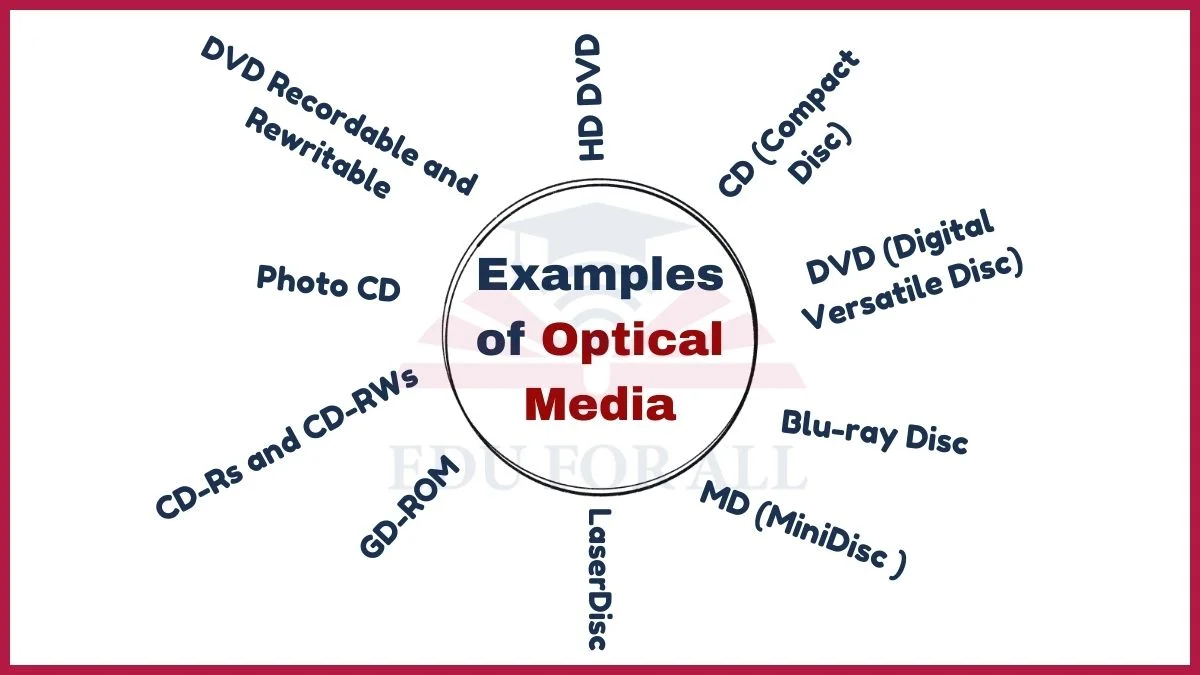Examples of Optical media include CDs, DVDs, laserdiscs, GD-ROM, Photo CDs, MiniDisc, CD-Rs, and CD-RWs.
Optical media refers to storage media that use laser light or electromagnetic waves near the light spectrum to read or write data onto optical discs like CDs, DVDs, and Blu-ray discs.
Examples of Optical Media
Here are the best examples of optical media:

1. CD (Compact Disc)
CDs are considered optical media because they store data that is read by a laser. A CD has a plastic disc coated with a thin reflecting aluminum layer and a protected label side. A CD player’s laser beam reads the disc by bouncing light off the reflective surface.
The first commercial compact disc was released in 1982.
2. DVD (Digital Versatile Disc)
DVDs are also an example of optical discs with higher storage capacity than CDs. They use a red laser to read data encoded in smaller pits. DVDs are used for larger data storage including movies, software, and multimedia content.
Single-layer DVDs store 4.7GB of data while double-layer DVDs store 8.5GB.
3. Blu-ray Disc
Blu-ray Discs (BD) represent a higher-capacity optical medium. It uses a blue-violet laser to read data. It supports high-definition video and audio. They derive their name from the blue-violet laser used for reading and writing data.
A single-layer Blu-ray Disc can store approximately 25 gigabytes of data, while a dual-layer disc can hold up to 50 gigabytes.
4. HD DVD (High-Definition Optical Disc)
HD DVD was a short-lived optical medium developed to compete with Blu-ray. It utilized a blue-violet laser to read and write data. It offers high-definition video and audio storage.
The format war between HD DVD and Blu-ray ended in 2008, with Blu-ray emerging as the dominant standard.
5. MD (MiniDisc )
The MiniDisc (MD) is an optical disc format designed for digital audio storage. It was popular for portable audio recording and playback in the 1990s. It offers a compact alternative to analog cassette tapes.
Sony introduced MiniDisc in 1992, aiming to replace cassette tapes with a smaller, rewritable digital format.
6. LaserDisc
LaserDiscs was one of the first optical media formats for home video playback. These discs utilized analog technology and were primarily used for video playback.
LaserDiscs were introduced in 1978 and provided better video quality than VHS tapes but faced challenges due to their larger size.
7. GD-ROM (Gigabyte Disc Read-Only Memory)
GD-ROM is an optical disc format developed by Sega for their Dreamcast gaming console. It is similar to a CD-ROM but with a larger storage capacity. GD-ROMs were used for distributing Dreamcast games. It takes advantage of their enhanced capacity for more extensive gaming experiences.
GD-ROMs have a storage capacity of around 1 gigabyte, providing ample space for game data and multimedia content.
8. CD-Rs and CD-RWs
CD-R (Compact Disc Recordable) and CD-RW (ReWritable) are optical discs where users can write data one time or rewrite it multiple times. Dye chemical change or phase change is used to record marks to be read optically.
CD-R and CD-RW capacity grew from an initial 650MB to 700MB of later versions.
9. Photo CD
Photo CD is an optical disc format specifically designed for storing digital images. It allows users to view, share, and print their photographs It provides a convenient way to manage and archive digital images.
Introduced in 1992, Photo CDs were an early attempt to transition from traditional film-based photography to digital image storage.
10. DVD Recordable and Rewritable
DVD Recordable (DVD-R/DVD+R), and DVD ReWritable (DVD-RW/DVD+RW) use optical technology allowing direct disc recording. Recording dye change allows burning of pits into blank disc area which laser reads optically. Can be written once or rewritten.
Most DVD writers support multiple recordable formats, storing 4.7GB single layer and 8.5GB dual layer.

